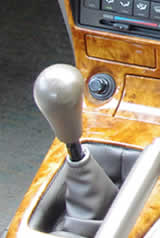Manual Transmissions and Oil Changes - Vol.135
Vehicles are built with different types of transmissions. Each has its own benefits and drawbacks. Manual transmissions are popular because they enable drivers to conserve fuel and better manage the performance of vehicles. And many drivers simply enjoy driving vehicles with manual transmissions more than those with automatic transmissions. Unfortunately, it is easy for inexperienced drivers to strip gears if they do not know how to properly drive a vehicle with a manual transmission. Even experienced drivers need to understand how manual transmissions work and ways to care for their vehicle.

How Manual Transmissions Work
Today, you can get vehicles with manual transmissions that have between three and six speeds. You can also get manual transmission with overdrive capabilities. A car that has a manual transmission requires the driver to shift transmission gears manually by using a gear stick and clutch. Unlike automatic transmissions that require transmission fluid for proper operations, a manual transmission typically requires transmission oil to lubricate gears.
Manual Transmission Problems
Generally, as long as you know how to properly shift gears, these transmissions last longer than automatic transmissions. However, there are possible problems drivers may experience with manual transmissions. A common one is the slipping of gears which can prevent your vehicle from staying at the proper speed. You may also experience difficulty in shifting gears. This can make it near impossible to drive a car with a manual transmission. If your car surges, it is possible your transmission is dirty and needs to be flushed. To determine the exact cause of your manual transmission problem, consider the conditions under which you first noticed the problem.
When to Change Oil
In most cases, gear oil rarely needs to be changed unless the manual transmission has been overhauled or extensive work has been done on it. Otherwise, your primary focus is on the transmission oil. If you hear a loud noise that sounds like a continuous whine while the car is running, it is a good idea to check the oil. Add oil if it is not full as indicated by the mark on the dipstick attached to the lid of the oil fill. In most cases, the noise will disappear when you begin to drive your car again. However, if you continue to hear strange noises, it may be because the transmission is contaminated and cannot function properly. Any time you have trouble shifting gears, you should have your transmission checked to make sure it is sufficiently oiled.
Choosing the Right Oil
Manual transmission fluids do not require frequent changes like those in automatic transmissions. But you still need to be prepared to change the oil when needed. Most drivers take their vehicles into repair shops or dealers to have oil changed. It is important the right oil is used in your car. Serious damage can be done if the wrong type of transmission oil is used. Some types of vehicles will need to use standard oil while others can use synthetic ones. The thickness of the oil is another important consideration. A thicker lubricant can make it difficult for gears to shift in cold weather while a thinner lubricant is equally problematic in hot weather.
Summary
Manual transmissions have been around since the first vehicle was made. Cars and trucks of all makes and models use these transmissions. It is important to take care of your transmission by keeping it well oiled. When you begin to experience surging or delayed movement in your car, you place yourself and others at risk by driving an unsafe vehicle. You can easily fix this problem by changing the transmission oil in your car!